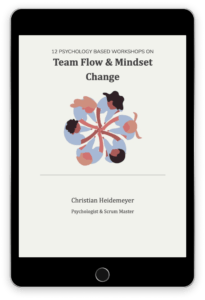Not enough time? You can go directly to the Agile Mindset Test, experience modern psychology in action, as well as understand you and your team better with this link:
Not only executives, but also agile coaches and managers tell us the same thing over and over again: “People simply lack the right, agile mindset.”
The truth behind this concept - how companies systematically prevent the right, agile mindset, and how to achieve the right scientifically-based mindset - can be found in this series of articles.
You can even take our online mindset test below!
Let's start with what we mean by the right mindset or the “agile mindset”. Which definition comes closest to a “truth” here? What does agile mindset mean?
The Definition of Agile Mindset - what does that even mean?
In order to come close to a "true" definition of mindset, we will use Stanford professor Carol Dweck's. definition. She has established a classification that can also be applied to the agile mindset.
Dweck (2006) differentiates between the fixed and growth mindset. People who tend to have a fixed mindset assume that their creativity, intelligence and talent are fixed, i.e. unchangeable.
The logical consequence of this attitude is that: Not much is worth trying. Mistakes are bad and you make them because you shouldn't be. Constructive criticism is useless. And so on.
On the other hand, people with a growth mindset believe in the possibility of constant personal development (Dweck, 2006). This leads to a transformation of the meaning of “effort” and “difficulty” - both are only part of the process.
The agile growth mindset perceives defeats as information about what to do differently and not as a diagnosis of low talent.
The diagram (based on the visualization of Nigel Holmes) looks at the difference of the mind sets again and shows its proximity to the agile context. What does agile mindset mean? It can be conveyed like this:

It is worth mentioning that the agile mindset can of course also be defined differently. In this article for example, Mischa Ramseyer from Pragmatic Solutions recognizes that the agile mindset rather than a general attitude to the agility and dynamic of a startup is where one's Competitive advantage ends. This would be a misunderstanding if it were based on Carol Dweck's definition.
The common misunderstanding of "agile mindset"
Many people tend to portray based on the "black and white" mindset - wrongly so.
Humans are not either A or B. There is a continuum between fixed and growth mindset, in which some tend towards a fixed and others towards a growth mindset (Burnette et al., 2013).
Likewise, it can vary between areas - I can have a fixed mindset regarding my creativity, but a growth mindset about dealing with difficult customers (Dweck, 1999).
The amazing benefits of an agile mindset
So we now know how to scientifically classify an agile mindset. But is it worth striving for a growth mindset at all? Definitely. In the following I would like to explain three of the advantages.
Advantage 1: Take constructive feedback better
In 2006, (Mangels et al., 2006) researching students conducted an ambitious general education test as a part of their studies. After each exercise, they were told whether their answer was right or wrong. If something was wrong, the correct answer was explained.
The clue: at the same time the brain waves of the test subjects were measured. Results showed that students with a growth mindset (vs. fixed mindset) showed more activity in brain areas during this explanation that are related to corrective feedback .

Fascinating to know is: The agile or growth mindset leads to more activity in brain areas that are related to the property “openness to feedback”.
So the growth mindset seemed to be one with higher attentiveness for constructive feedback. And indeed: when the test was carried out again, subjects with a growth mindset showed better results than those with a fixed mindset!
So the growth mindset makes learning from feedback easier, as attention paid to the feedback process itself is increased. Every feedback is seen from the perspective of a growth mindset as a learning opportunity. This could be seen as essential in the working world.
Advantage 2: Introverts integrated in team meetings
How do you get more introverted people in agile retrospectives to express their opinion more often? Encourage them to have a growth mindset for their social skills, because our mindset actually influences how we deal with social situations (Beer, 2002).
People with a growth mindset believe that they can improve their sociability and overcome their shyness. They perceive social situations as valuable opportunities to learn.
Introverts with a growth or agile mindset are perceived as socially more competent than introverts with a fixed mindset, although both are technically "equally introverted".
Therefore, it seems possible that the strengths of the personality type "rather introverted" can be better integrated into team communication this way.
Advantage 3: Strengthen the error culture
How can you improve togetherness, avoid rash judgments among yourselves and thus improve error culture in a business?
Give team members a growth mindset. A fixed mindset can lead to people being misunderstood as a single undesirable behavior for who they are as a person (Dweck, Chiu, Hong, 1995).
This means that one can have a tendency to speak with prejudice (Levy, Stroessner & Dweck, 1998) and we can assume that people with a fixed mindset can punish others for who they are.
In addition, a study (Chiu, Dweck, Tong & Fu, 1997) shows the following: Students with a fixed mindset wanting to punish a professor for changing the grade in the last second.
Students with a growth mindset, on the other hand, were rather unsuccessful in doing so and aimed to educate the professor how to make better decisions in general.
Mistakes made with a growth (i.e. agile) mindset are interpreted as a source of learning not only for yourself, but also with others (as opposed to being evidence for incompetence).
This indirectly creates an atmosphere of psychological security that distinguish high performance teams. Correspondingly, dealing more openly with mistakes is another useful byproduct of the growth mindset.
Agile mindset - an interim conclusion
Altogether, it seems comprehensible that the growth mindset goes hand in hand with more effective learning (Kray & Haselhuhn, 2007), higher work performance (Payne, Youngcourt & Beaubien, 2007), job satisfaction and more innovative behavior (Janssen & Yperen, 2004).
The question is: Can you foster the agile mindset? The answer to this seems easy. After all, providers like Pink University offer training for the agile mindset.
Another example: an important element in training the agile mindset can be the agile retrospective. This type of team workshop is suitable in any context, whether Scrum, Kanban, OKRs or Waterfall.
Good (!) retrospectives help to establish the agile mindset in the long term. Which is is also the goal of our team development or retrospective tool Echometer.
We are a spin-off from the Psychological Faculty of the University of Münster. Our software tool helps you to facilitate retrospectives - including psychological nudges.
You can conduct a retrospective with our tool without anyone having to register by the way ⏫
You can use this button to open the tool and conduct a retrospective on “Team Morale”:
Note: This retrospective format asks for agreement with the given Health Check items on a scale.
- Appreciation: My colleagues appreciate my contribution to the team.
- Team Spirit: There is a trusting working atmosphere in our team.
- Transparency: Everyone in my team knows who is currently working on what.
- Recovery & Breaks: I have enough room for breaks in which I can draw new energy.
- Meeting culture: Our meetings are well structured, yet leave room for creativity and new ideas.
- Support: In my team, each team member passes on their individual knowledge and experience.
There are more than 30 kickass retrospective methods available. But for now, let's come back to other methods to develop the agile mindset.
What remains interesting is: Why do many companies prevent the development of an agile mindset?
The truth: How companies systematically prevent the agile mindset
Many different studies have shown that mindset training can actually work - creating an agile mindset is completely possible.
In this respect, the title of Svenja Hofert's book “The agile mindset: developing employees, shaping the future of work" is not wrong.
As a small example:
Researchers trained the mindset of a school class and showed that students were less sick, less stressed, and better performing eight months later.
Yeager et al. (2014). You can find more examples in one Ted-Talk by Carrol Dweck.
If you're saying "Wow! I want this training too,” good, then read on.
We have, based on the work of Keating and Heslin (2015) , recorded what needs to be done to develop mindsets.
First of all: The sad and astonishing truth is that many companies would first have to work fundamentally on the company culture in order to achieve long-term positive effects on the agile mindset.
Step 1: Develop an agile mindset - at company level
In 1998, two researchers manipulated (Mueller & Dweck) test subjects specifically in a study, so that afterwards half of the test subjects had a fixed and the other half had a growth mindset.
How? Quite simply: In the fixed mindset group, they told the participants that they had achieved the good results of a previous test because of their high “intelligence”.
They created the Growth Mindset group by justifying this with the “effort” of the test subjects.
And now this is where its gets interesting: The two groups were then given a more difficult task. If the test subjects failed here, those with the induced fixed mindset reported that they found the task less fun.
They also made less effort and did not last as long when it came to processing tasks.
How is the fixed mindset often induced in companies? Murphy and Dweck (2010) ask in “Genius Cultures”. According to the researchers, these are characterized by artifacts such as newsletters, speeches by top management, and by defined promotion criteria and reward systems.
In such cultures, executives often speak of “star performers”, very “talented” or “talented” employees, or “high potentials” (Michaels, Handfield-Jones, & Axelrod, 2001).
all of this supports the fixed mindset worldview:
Fixed Mindset: Some are talented, creative and intelligent from birth - and others are not.
The Enron company, for example, boast of only recruiting the smartest. At the same time, employees who belong to the worst 10% to 15% are fired.

Superman: Innate talent. A (beautiful) story, which unfortunately underlines the anchoring of the fixed mindset in our culture.
This leaves no doubt that employees can hardly be further developed, from the perspective of management - the fixed mindset is therefore promoted (Keating & Heslin, 2015).
Interim conclusion - develop an agile mindset
An important step in the challenge of changing people's mindset, must be to adapt the company's internal and external communication.
Growth cultures are characterized by the fact that there is one collective belief in the ubiquitous possibility of further development. The corresponding signs must be made public by the company.
More specifically, you can make the following offers, for example: peer mentoring, 360º feedback, coaching, training leave, job shadowing and job rotations.
Managers, of course, also play a key role in how culture is perceived.
Step 2: Develop an Agile Mindset - The Significant Role of Managers
A first step that managers should take: publicly celebrate substantial employee developments in all areas.
In the communication between managers and senior management, there must always be resonance:
Good employees are not good because they are smart. They are good because they work hard.
In general, any feedback related to who you are as a person, should be avoided. Feedback related to processes is more beneficial, and enable learning and performance improvements - i.e. on things that can be changed (e.g. hard work, looking for feedback, systematic planning; Cimpian, Arce, Markman, & Dweck, 2007).
In relation to this, it makes sense not to set performance goals, but learning goals (VandeWalle, 1997). You can find more about this important, but little-known division of goals in my blog article about it.
A strategic leadership style that fits well with the agile or growth mindset is described right here Amy Edmonson focuses on learning with this principle:
As managing directors, we also don't know everything, make mistakes, and have to learn for ourselves what is the best way. There is no fixed, correct way.
Amy Edmonson
Appropriately, Edmondson recommends the corporate strategy as a hypothesis to formulate, and not as something fixed and unquestionable.
So every manager is clear that, "I (they) may doubt," which means that psychological safety is promoted, and at the same time indirectly communicated to everyone that senior management is constantly developing.
It is a given that executives must first be able to lead themselves to lead their employees (# classic).
This also applies if you want to cultivate the growth mindset. If managers themselves respond to challenges and defeats with a fixed mindset, they should first work on themselves. Exercises for this can be found here in our third blog post.
There are of course also various sources of training - for example by Svenja Hofert, the author of "Das agile Mindset".
Finally, it should be added that it is of course not enough to change forms of communication. What is communicated externally by the company must of course also be performed.
For example, there could theoretically be a bonus for the operating effort of employees - not for their results.
Conclusion & "How to agile mindset" in the team
We now know the benefits of the agile growth mindset. We also know that mindsets can be actively brought about, and that they can be trained - although many corporate cultures prevent them at the same time.
In the next article we go one step further – and explain the surprisingly simple, scientifically validated training to bring about the agile mindset in your team in a targeted manner.
You can access the online test for the agile mindset via the link above 🙂
Agile Mindset Sources
Beer, JS (2002). Implicit self theories of shyness. Journal of Personality and Social Psychology, 83, 1009-1024.
Burnette, JL, O & #8217; Boyle, EH, VanEpps, EM, Pollack, JM & Finkel, EJ (2013). Mind-sets matter: A meta-analytic review of implicit theories and self-regulation. Psychological Bulletin, 139(3), 655-701.
Cimpian, A., Arce, HMC, Markman, EM, & Dweck, CS (2007). Subtle linguistic cues affect children & #8217; s motivation. Psychological Science, 18 (4), 314-316.
Chiu, C.-Y., Dweck, CS, Tong, JY & Fu, JH (1997). Implicit theories and conceptions of morality. Journal of Personality and Social Psychology, 73, 923-940.
Dweck, CS, Chiu, C. & Hong, Y. (1995). Implicit Theories and Their Role in Judgments and Reactions: A Word From Two Perspectives. Psychological Inquiry, 6(4), 267-285.
Dweck, CS (1999). Essays in social psychology. Self-theories: Their role in motivation, personality, and development. New York, NY, US: Psychology Press.
Dweck, CS (2006). Mindset: The new psychology of success. New York: Random House.
Janssen, O & Yperen, N. (2004). Employees & #8216; Goal Orientations, the Quality of Leader-Member Exchange, and the Outcomes of Job Performance and Job Satisfaction. The Academy of Management Journal, 47, 368-384.
Keating, LA, & Heslin, PA (2015). The potential role of mindsets in unleashing employee engagement. Human Resource Management Review, 25 (4), 329-341.
Kray, L. & Haselhuhn, M. (2007). Implicit negotiation beliefs and performance: experimental and longitudinal evidence. Journal of Personality and Social Psychology, 93(1), 49-64.
Levy, SR, Stroessner, SJ & Dweck, CS (1998) Stereotype formation and endorsement: The role of implicit theories. Journal of Personality and Social Psychology, 74, 1421-36.
Mangels, JA, Butterfield, B., Lamb, J., Good, C. & Dweck, CS (2006). Why do beliefs about intelligence influence learning success? A social cognitive neuroscience model. Social Cognitive and Affective Neuroscience, 1(2), 75-86.
Michaels, E., Handfield-Jones, H., & Axelrod, B. (2001). The was for talent. Boston, MA: Harvard Business School Press.
Mueller, C., & Dweck, C. (1998). Praise for intelligence can undermine children & #8217; s motivation and performance. Journal of Personality & Social Psychology, 75, 33-53.
Murphy, MC, & Dweck, CS (2010). A culture of genius: How environments lay theories shape people & #8217; s cognition, affect and behavior. Personality and Social Psychology Bulletin, 36, 283-296.
Payne, S., Youngcourt, S. & Beaubien, J. (2007). A meta-analytic examination of goal orientation and nomological net. Journal of Applied Psychology, 92(1), 128-150.
Hofert, S. (2018). The agile mindset. Wiesbaden: Springer trade media.
VandeWalle, D. (1997). Development and validation of a work domain goal orientation instrument. Educational and psychological measurement, 57 (6), 995-1015.
Yeager, DS, Johnson, R., Spitzer, BJ, Trzesniewski, KH, Powers, J., & Dweck, CS (2014). The far-reaching effects of believing people can change: Implicit theories of personality shape stress, health, and achievement during adolescence. Journal of Personality and Social Psychology, 106, 867-884.










